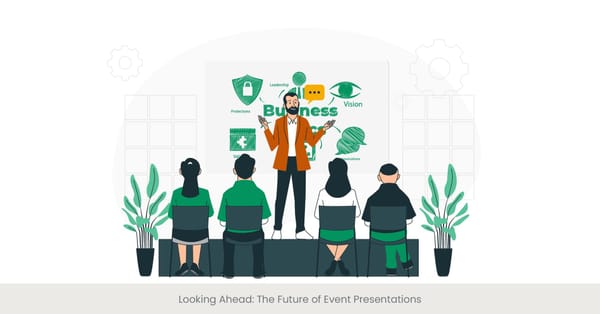
Crafting a Compelling Narrative for Keynotes

In today’s high-stakes environment, creating the perfect presentation is crucial for success. Whether it’s a keynote speech deck, a conference presentation design, or an investor outreach slide deck, the quality of your presentation design can significantly influence how your message is received. A well-crafted presentation not only conveys your message effectively but also reinforces your authority in the field.
Engaging Beginnings: The Art of Crafting Compelling Narratives
Crafting a compelling narrative is the foundation of any memorable keynote and conference presentation. It's about weaving a story that not only informs but also entertains and inspires your audience. This introductory section delves into the significance of narrative structure, emphasizing its role in capturing and maintaining the audience's attention. By setting the stage with an engaging narrative, speakers can establish a connection with their audience, making their message more relatable and impactful.
The Backbone of Storytelling
Behind every compelling narrative is a well-thought-out structure. This involves setting a clear beginning, middle, and end, each serving a distinct purpose in the overall story. The beginning sets the context and introduces the main characters or ideas, the middle elaborates on the challenges or conflicts, and the end provides resolution. This structure helps in presenting key information in a logical and engaging manner, ensuring that the audience follows along and absorbs the intended message.
Real-World Narratives in Action
Illustrating this concept with real-world examples, consider how renowned speakers use personal anecdotes, historical events, or hypothetical scenarios to frame their presentations. These narratives are often rooted in universal themes such as overcoming adversity, innovation, or teamwork, making them resonate with diverse audiences. For instance, Steve Jobs' 2005 Stanford commencement speech skillfully narrated his personal and professional journey, weaving in lessons on resilience and curiosity, thereby leaving a lasting impression on his audience.
Narratives That Resonate: Evidence and Impact
Research supports the effectiveness of narrative storytelling in presentations. Studies show that stories are 22 times more memorable than facts alone. Furthermore, a well-crafted narrative can significantly enhance audience engagement, making the presentation more impactful and memorable. Incorporating narratives not only helps in conveying complex ideas more clearly but also in establishing an emotional connection with the audience, a key factor in the success of keynote and conference presentations.
If you're looking to create a stunning keynote or conference presentation, check out our design solutions at INK PPT.
Techniques for Effective Storytelling in Presentations
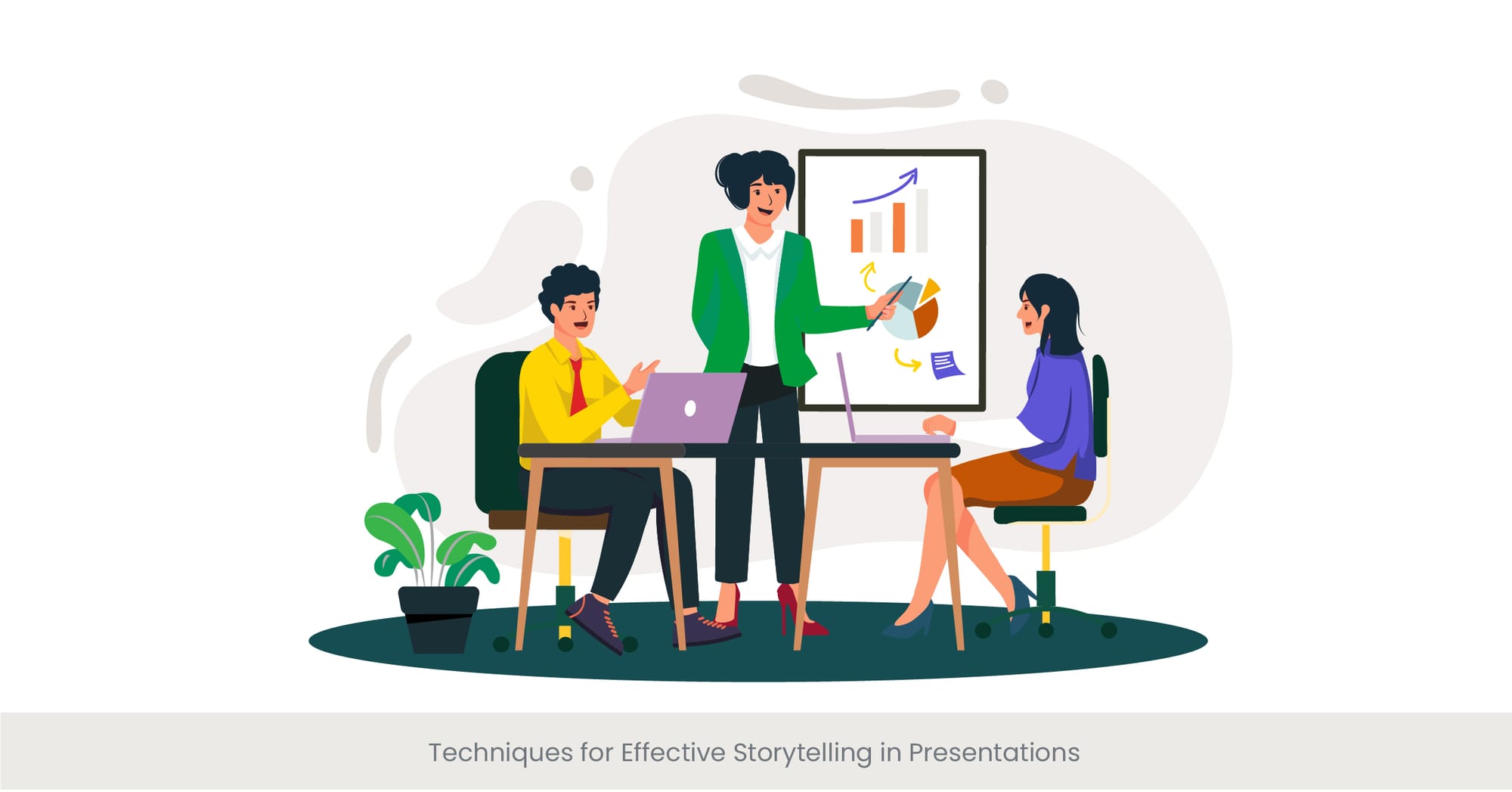
Unlocking the Power of Storytelling
Effective storytelling in keynote and conference presentations transcends mere recitation of facts; it involves crafting a narrative that engages, persuades, and moves the audience. This segment explores the techniques that transform simple presentations into riveting stories, focusing on the art of narrative delivery. By leveraging the power of storytelling, speakers can turn their presentations into memorable experiences that resonate with their audience on a deeper level.
Foundations of Engaging Storytelling
Understanding the core elements of storytelling is crucial. This includes the development of a clear plot, relatable characters, and a compelling conflict or challenge that hooks the audience. Incorporating these elements with purpose and precision is key to capturing and maintaining the audience's interest. The background of storytelling techniques stretches back to ancient oral traditions, where storytellers used these components to convey complex ideas and values. Today, these timeless principles still hold, underscoring the importance of a well-structured narrative in presentations.
Bringing Stories to Life: Examples and Applications
To illustrate, consider the use of storytelling in TED Talks, where speakers often start with personal anecdotes or surprising facts to engage the audience. These stories are not just entertaining; they serve to highlight the speaker's main points, making the presentation more relatable and the message more impactful. For example, Chimamanda Ngozi Adichie's "The Danger of a Single Story" uses personal narratives to explore complex themes of stereotypes and cultural understanding, demonstrating the profound effect of storytelling on conveying deep insights.
The Science Behind Storytelling
Research underpins the efficacy of storytelling in presentations, revealing that narratives can significantly enhance memory retention and emotional engagement. A study published in the Journal of Cognitive Neuroscience found that storytelling activates not only the language-processing parts of our brains but also those involved in experiencing the events of the story. This dual activation makes stories much more engaging than abstract presentations, facilitating a deeper connection with the audience and a more lasting impact.
Engaging Different Types of Audiences

Understanding Your Audience: The Key to Effective Presentations
The effectiveness of keynote and conference presentations largely hinges on the speaker's ability to engage with their audience. However, audiences are not monolithic; they come from diverse backgrounds, possess varying levels of knowledge, and have different expectations. This section underscores the importance of audience analysis as a foundational step in preparing for any presentation. Tailoring your message and delivery style to match the audience's profile ensures that your presentation resonates with them, fostering engagement and comprehension.
Diverse Audiences, Diverse Strategies
Engaging different types of audiences requires an adaptable approach. Whether you're addressing industry experts at business conferences or a general audience at academic conferences, understanding the common interests, level of expertise, and what motivates your audience is crucial. For instance, technical jargon may be appropriate for a specialized audience but could alienate a general audience. This section explores strategies such as audience segmentation and personalized messaging to effectively connect with and engage various audience groups.
Real-World Engagement: Case Studies and Trends
To bring these concepts to life, consider the approach of seasoned speakers who excel in adapting their presentations based on their audience. For example, at TED conferences, speakers often employ a mix of humor, storytelling, and visuals to appeal to a broad audience, while maintaining depth and substance. Another case is academic conferences, where presenters may focus more on data and research findings, using technical language that resonates with an academic audience. These examples illustrate the importance of audience awareness and the use of tailored strategies to enhance engagement.
Audience Engagement: Insights and Evidence
The significance of engaging different types of audiences is backed by research. Studies suggest that audience-tailored messages are more likely to be persuasive and remembered. A review in the Journal of Marketing highlighted that presentations adapted to the audience's values and beliefs significantly increased engagement and message effectiveness. By integrating audience-specific insights and adapting your presentation accordingly, you can ensure that your message not only reaches your audience but also engages them effectively.
Want to know how INK PPT helped clients like you deliver unforgettable presentations?
Utilizing Visual Aids in Conference Presentations
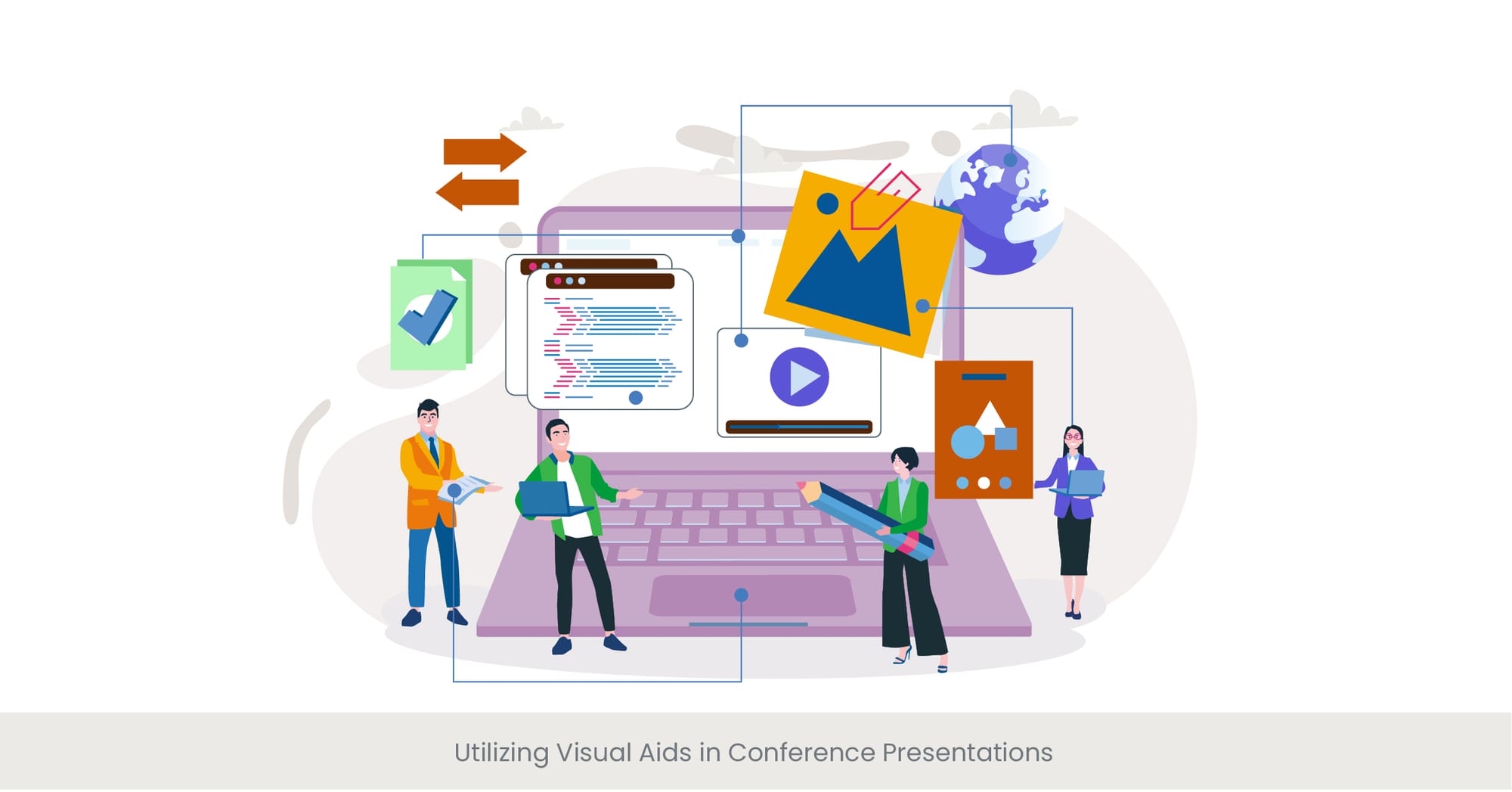
Enhancing Presentations with Visual Aids
Visual aids play a pivotal role in enhancing the effectiveness of keynote and conference presentations. They serve not only to illustrate and clarify complex ideas but also to engage the audience's attention and facilitate better understanding and retention of information. This section highlights the importance of carefully selecting and integrating visual aids into your presentation to support your message and objectives, ensuring they add value rather than distract or overwhelm.
The Art of Visual Communication
Choosing the right visual aids involves more than just adding images or slides; it requires a thoughtful approach to visual communication. Whether it's presentation templates, conference PowerPoint slides, or diagrams or engaging infographics, each visual element must be purposefully designed to complement and reinforce your narrative. This part delves into the principles of effective visual design, including simplicity, consistency, and relevance, guiding speakers on how to create visuals that resonate with their audience and enhance the overall impact of their presentation.
Real-World Impact: Visual Aids in Action
In practice, successful speakers utilize visual aids to bring their presentations to life. From Steve Jobs' iconic keynote presentations, which masterfully combined minimalistic slides with powerful imagery, to the use of engaging videos and animations in TED Talks, these examples demonstrate the transformative power of visuals. By examining these case studies, presenters can glean insights into how effective visual aids can significantly amplify the message and engage the audience, making complex concepts more accessible and memorable.
Validating Visuals: Research and Recommendations
The effectiveness of visual aids in presentations is well-supported by research. Studies have shown that people are more likely to remember information presented with relevant visuals compared to text alone. For instance, the Picture Superiority Effect, a principle in cognitive psychology, suggests that images are more likely to be remembered than words. Moreover, incorporating visuals into presentations has been proven to increase audience engagement and retention, making them a critical component of successful conference and keynote presentations.
Strategies for Memorable Closing Remarks

Crafting the Perfect Conclusion
The conclusion of a keynote or conference presentation is your final opportunity to leave a lasting impression on your audience. Memorable closing remarks can reinforce your message, encourage action, and ensure your presentation resonates long after it has ended. This section focuses on the strategies for crafting impactful conclusions that effectively summarize the session' key points and inspire your audience.
The Essence of a Powerful Close
A strong conclusion goes beyond merely summarizing the presentation; it connects back to the opening, reiterates the presentation tips main message, and leaves the audience with something to ponder or act upon. Whether it's a compelling quote, a thought-provoking question, or a call to action, the end of your presentation should feel like a satisfying resolution to the narrative you've built. This part explores the techniques for achieving such an ending, emphasizing the importance of coherence, emotional appeal, and relevance to the audience's interests and needs.
Illustrating Success: Memorable Conclusions in Practice
Examining real-world examples, such as the impactful closing remarks by speakers at various conferences, sheds light on the art of concluding a presentation effectively. For instance, Martin Luther King Jr.'s "I Have a Dream" speech is renowned not only for its powerful message but also for its unforgettable conclusion, which masterfully encapsulated the essence of his vision and inspired action. Similarly, in the business and academic worlds, successful speakers often conclude with a strong statement or a summary that reinforces the presentation's theme and motivates the audience toward a desired outcome.
Backing It Up: The Importance of Memorable Endings
Research underscores the significance of an effective conclusion. The serial position effect, a principle from psychology, suggests that individuals are likely to remember the first and last items in a series best (the primacy and recency effects, respectively). This highlights the critical role of closing remarks in ensuring your presentation's key messages are remembered. Studies in communication suggest that a well-crafted conclusion can enhance the persuasiveness of your presentation and significantly impact the audience's perception and recall of the information presented.
Preparing for High-Stakes Keynote Presentations

The Art of Preparation
High-stakes presentations require a deep understanding of your audience and the context. If you’re preparing for a keynote speech deck, start by researching your topic thoroughly and tailoring your content to engage your audience. The same goes for conference presentation designs – knowing the conference theme and designing your slides to support your narrative is crucial for keeping the audience engaged.
Foundational Elements of Effective Preparation
Effective preparation doesn’t end with content creation. A keynote speech deck should tell a story, using clear and engaging visuals to support your message. Similarly, for conference presentation designs, it's important to ensure the visuals are not just aesthetic but functional, aiding your verbal delivery. When preparing investor outreach slide decks, keep in mind that simplicity and clarity are paramount, as investors value concise and impactful presentations.
Case Studies: Preparation in Action
The most successful keynote speakers, such as those at TED or SXSW, often use effective keynote speech decks that captivate audiences right from the start. These speakers spend hours perfecting their conference presentation designs, ensuring that each slide adds value to the story they are telling. On the other hand, investor outreach slide decks often feature data-driven visuals and crisp, well-organized slides to secure investor confidence and funding.
Research-Backed Strategies for Preparation
The importance of preparation is further supported by research on effective communication and presentation skills. Studies have shown that audience engagement and message retention significantly improve when speakers are well-prepared, utilize engaging visuals, and deliver their content confidently. Furthermore, the practice has been linked to reduced public speaking anxiety, enhancing the speaker's ability to connect with the audience and convey their message effectively.
Handling Nerves and Building Confidence

Mastering the Mindset for Public Speaking
Public speaking, particularly in the context of keynote and conference presentations, can be a daunting task, even for experienced speakers. Handling nerves and building confidence are crucial aspects of delivering a successful presentation. This section explores strategies for overcoming anxiety and fostering a confident presence on stage. Understanding that nerves are a natural response to high-stakes situations can help speakers channel this energy positively, enhancing their performance rather than hindering it.
Techniques for Overcoming Speaking Anxiety
There are several effective techniques to manage nerves and boost confidence before stepping onto the stage. Deep breathing exercises, visualization techniques, and positive affirmations can help calm the mind and reduce anxiety. Additionally, thorough preparation, including rehearsing your presentation multiple times and familiarizing yourself with the venue, can significantly alleviate stress. This part delves into these strategies, offering practical advice for speakers to feel more in control and confident during their presentations.
Real-World Examples: Confidence in Action
Drawing inspiration from seasoned speakers can provide valuable insights into managing nerves. For instance, many TED Talk presenters share their experiences of overcoming stage fright through rigorous preparation, mindfulness practices, and focusing on the message they want to convey rather than on their own fears. These stories illustrate that confidence is often the result of deliberate practice and mental preparation, emphasizing that even the most successful speakers have worked hard to master their public speaking fears.
Evidence-Based Approaches to Building Confidence
Research in the field of psychology offers evidence-based approaches to tackling public speaking anxiety. Studies suggest that exposure therapy, which involves gradually and repeatedly exposing oneself to the feared situation, can be effective in reducing fear of public speaking. Moreover, cognitive-behavioral strategies, such as challenging negative thoughts and practicing relaxation techniques, have been shown to improve confidence and performance in high-pressure situations like keynote presentations.
Feedback and Iteration for Presentation Improvement
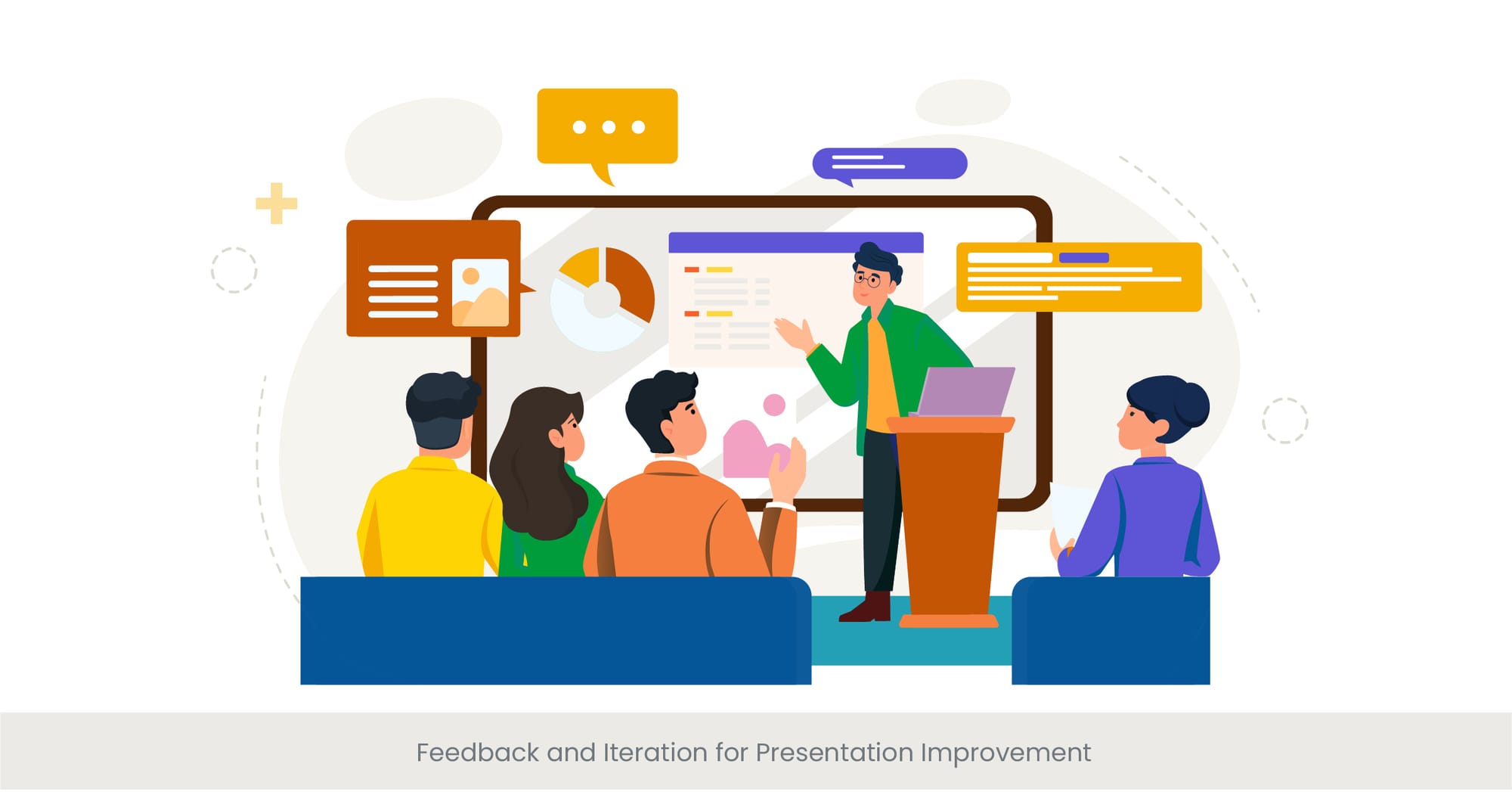
The Cycle of Continuous Improvement
Feedback and iteration play critical roles in refining keynote and conference presentations. This section emphasizes the value of constructive criticism and the iterative process in enhancing your speaking skills and presentation content. Incorporating feedback allows speakers to identify areas for improvement and adjust their approach, ensuring their presentations become more effective and engaging over time. This cycle of preparation, presentation, feedback, and revision is fundamental to mastering the art of public speaking.
Embracing Feedback for Growth
Seeking and embracing feedback, whether from peers, mentors, or audience evaluations, can provide invaluable insights into your presentation's strengths and weaknesses. Constructive criticism is not just about highlighting areas for improvement; it's also about recognizing what works well and should be retained or amplified in future presentations. This part explores strategies for collecting feedback, including post-presentation surveys, direct audience interaction, and professional coaching, offering guidance on how to interpret and act on the feedback received.
Real-World Application: Learning from Experience
Many renowned speakers attribute a significant part of their success to the feedback loop. For instance, after every keynote presentation, they analyze audience reactions, review recordings of their speeches, and seek direct feedback to identify areas for improvement. This continuous learning process enables them to adapt their content, refine their delivery, and better engage with their audiences in subsequent presentations. By highlighting these examples, this section illustrates the practical benefits of feedback and iteration in the context of public speaking.
The Impact of Iteration: Research Insights
Research supports the effectiveness of feedback and iterative practice in skill development, including public speaking. Studies in educational psychology have shown that iterative learning, characterized by repeated cycles of practice, feedback, and adjustment, leads to greater proficiency and confidence. This evidence underscores the importance of viewing each presentation as an opportunity to learn and grow, emphasizing that the path to becoming an accomplished speaker is a journey of continuous improvement.
Leveraging Social Media for Pre-Event Buzz

Creating Anticipation Through Digital Channels
In the digital age, leveraging social media has become a critical strategy for amplifying the reach and impact of keynote and conference presentations. This section explores how speakers and event organizers can create pre-event buzz, engaging potential attendees and expanding the audience beyond the physical venue. Utilizing platforms like Twitter, LinkedIn, and Instagram allows for the sharing of sneak peeks, key insights, and interactive content, building anticipation and driving interest in the upcoming presentation.
Strategies for Social Media Engagement
Effective social media engagement requires a strategic approach. This includes identifying the most relevant platforms for your target audience, crafting compelling content that reflects your audience follow the theme of your presentation, and encouraging interaction through questions and discussions. Additionally, using hashtags, live videos, and stories can enhance visibility and engagement. This part provides a roadmap for utilizing social media to not only generate buzz but also establish a connection with your audience before the event even begins.
Success Stories: Social Media in Action
Examples of successful pre-event social media campaigns demonstrate the power of digital engagement. For instance, conferences like SXSW and TEDx extensively use social media to tease topics, highlight speakers, and share content related to their events, significantly increasing reach and engagement. These case studies showcase innovative ways to use social media, from behind-the-scenes glimpses to interactive Q&A sessions, illustrating how these tactics can create a sense of community and anticipation around an event.
The Impact of Social Media: Evidence and Insights
Research highlights the effectiveness of social media in event promotion and engagement. A study published in the Journal of Marketing Research found that social media buzz can significantly influence event attendance and audience engagement, suggesting that digital engagement strategies can complement traditional marketing efforts. By leveraging the power of social media, speakers and event organizers can not only generate interest in their presentations but also enhance the overall event experience.
Analyzing Impactful Keynote Presentations

Decoding the DNA of Memorable Speeches
Understanding what makes certain keynote presentations stand out and resonate long after the event has concluded is crucial for any speaker aiming to make an impact. This section delves into the analysis of impactful keynote presentations, exploring the common elements that contribute to their success. By dissecting memorable speeches, we can uncover the techniques and strategies that make them effective, providing valuable lessons for future presentations.
Key Components of Successful Presentations
The most memorable keynote speech decks incorporate powerful storytelling and engaging visuals. Analyzing these impactful presentations will give you insights into how to improve your own conference presentation designs and investor outreach slide decks. Whether it's Steve Jobs' iconic product launch or a pitch that successfully secured millions in funding, these examples reveal the power of great slide design and delivery.
Learning from the Masters
Analyzing keynote presentations by speakers such as Steve Jobs, Brené Brown, or Sir Ken Robinson offers insights into the art of captivating an audience. These speakers excel in engaging their listeners through personal anecdotes, humor, and a deep understanding of their subject matter. By studying their techniques, such as the strategic use of pauses, variations in tone, and audience interaction, speakers can glean valuable strategies for enhancing their own presentations.
Research and Recommendations for Impactful Presentations
Research on communication and psychology provides evidence-based recommendations for creating impactful presentations. For example, studies emphasize the importance of storytelling and emotional appeal in enhancing audience engagement and retention of information. Furthermore, the effective integration of visual aids and the importance of rehearsing to refine delivery are also supported by academic findings. This section highlights key research insights and offers actionable advice for speakers aiming to make their keynote presentations more impactful.
If you still have questions about creating the perfect presentation, let’s chat.
FAQs on Keynote and Conference Presentations
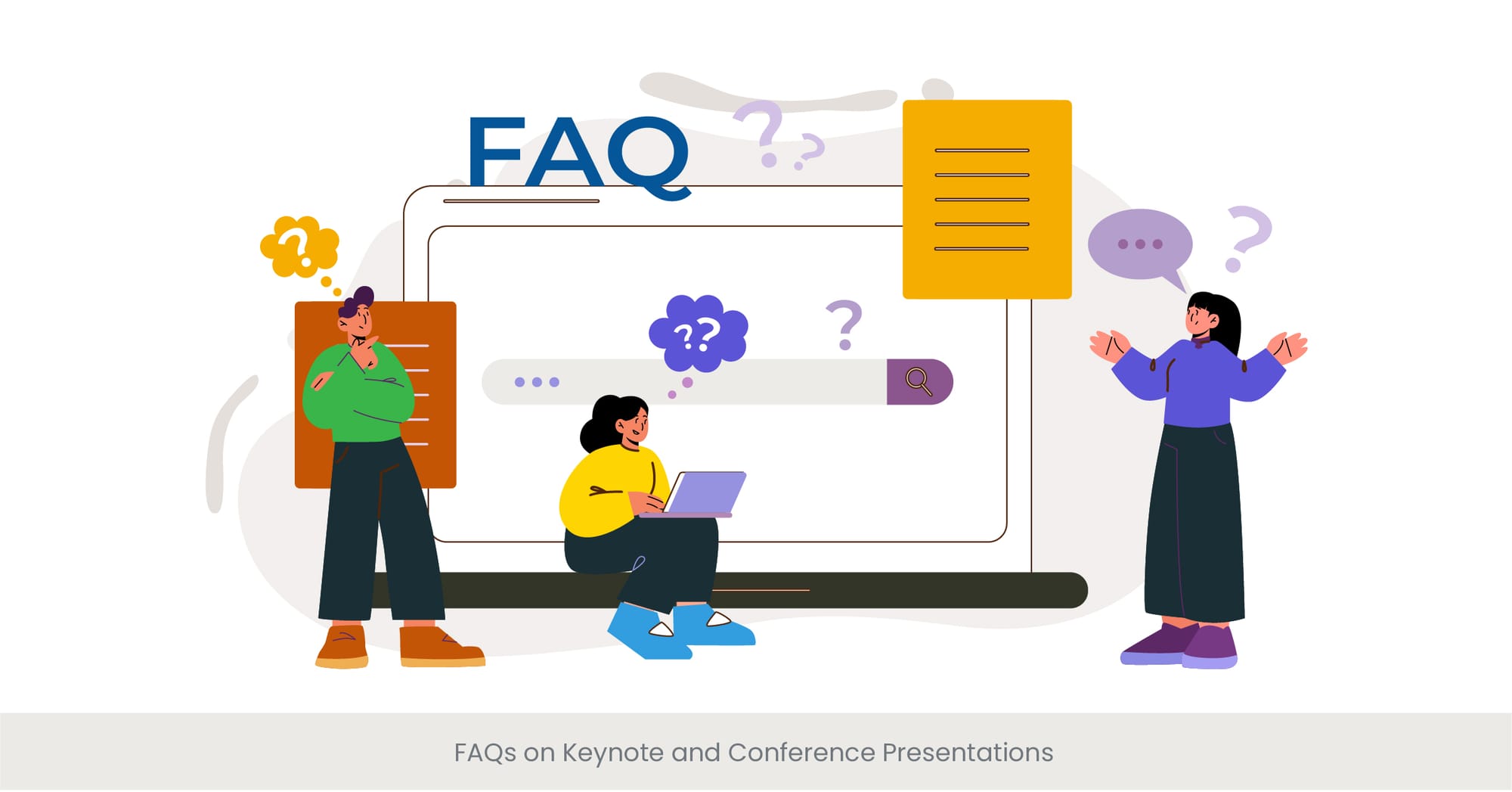
What is a Keynote Presentation?
A keynote presentation serves as the cornerstone of a conference, setting the tone and theme for the event. It's typically delivered by a prominent speaker who can inspire and engage the audience, offering valuable insights related to the next conference call's core topic.
What is the difference between PowerPoint and Keynote presentations?
PowerPoint, a product of Microsoft, and Keynote, developed by Apple, are both presentation software but differ in user interface, design templates, and functionalities. While PowerPoint is widely used across various platforms, Keynote is known for its advanced graphic capabilities and is primarily used on Apple devices.
How do you make a good Keynote presentation?
Creating a compelling keynote presentation involves clear articulation of your message, integrating storytelling, utilizing engaging visuals, and practicing your delivery. Tailoring the content to your audience's interests and expectations is also key to making your presentation resonate.
Is Keynote presentation free?
Keynote is available to download for free on Apple devices, including Mac, iPad, and iPhone, offering a suite of design tools and templates to create engaging presentations.
What is an oral presentation at a conference?
An oral presentation at a conference involves delivering your research findings, project updates, or expert insights to an audience, typically accompanied by visual aids such as slides. It's a platform for sharing knowledge and fostering academic or professional discussions.
How do you present an oral paper in a conference?
Presenting an oral paper involves summarizing your research or paper's key points, explaining the methodology, results, and conclusions, and highlighting the significance of your findings. Engaging the audience with clear explanations and visual aids is crucial for an effective presentation.
What are the 4 types of oral presentation?
The four types include informative, demonstrative, persuasive, and inspirational presentations, each serving different purposes, from educating the audience about a whole idea or specific topic to motivating them towards certain actions or changes.
How do you present a conference presentation?
Effective conference presentations require a well-organized structure, engaging content, clear visuals, and confident delivery. Engaging your audience with questions, interactive elements, and compelling storytelling can enhance the impact of your presentation.
What is the 5 golden rule of PowerPoint presentation?
The five golden rules include keeping slides simple and uncluttered, using visuals to complement your message, limiting bullet points, charts and text, practicing consistent design, and rehearsing your delivery to ensure a smooth presentation.
How many slides should a conference presentation have?
The number of slides should align with the presentation's length, aiming for a balance that allows you to convey your message effectively without rushing or overloading the audience. A common guideline for slide amount is one slide per minute of presentation time.
What is the first slide of a conference presentation?
The first slide typically includes the presentation's title, the speaker's name, and their affiliation, setting the stage for the audience by introducing the topic and the speaker.
How do you present a press conference?
Presenting at a press conference involves preparing a statement or announcement, addressing the media's questions, and delivering your message clearly and concisely. Engaging with the media positively and professionally is key to effectively conveying your information.
What do you say at the beginning of a press conference?
The beginning of a press conference usually starts with a greeting, followed by an introduction of the topic or purpose of the conference, thanking attendees for their presence, and outlining what will be discussed during allocated time.
What is press conference examples?
Press conference examples include product launches, crisis management responses, policy announcements by government officials, or any event where organizations or individuals aim to communicate directly with the media.
What are the do's and don'ts of press conference?
Do's include preparing thoroughly, being clear and concise, staying on message, and engaging respectfully with the media. Don'ts include avoiding questions, providing misleading information, or being confrontational.

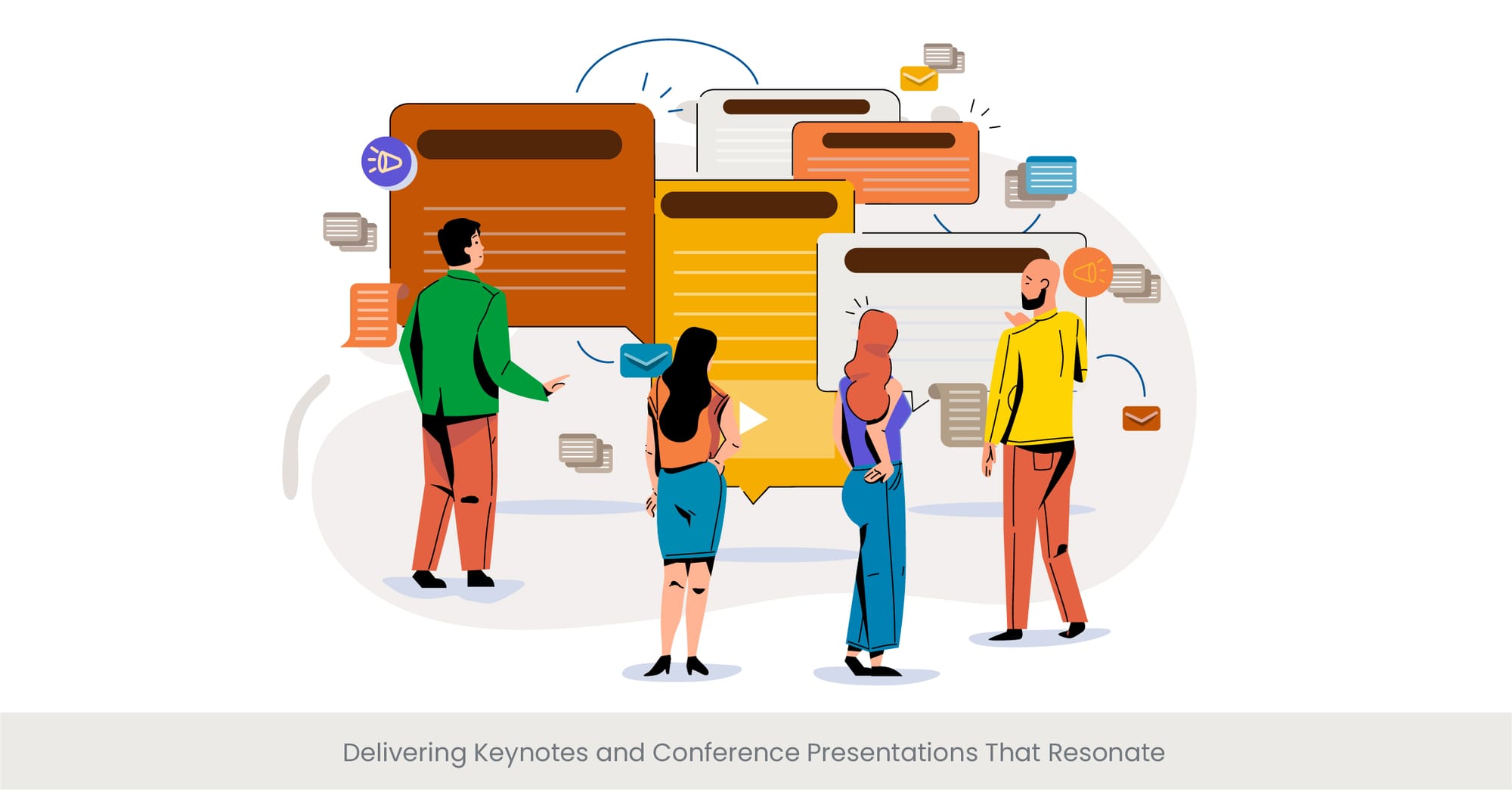

%20(1).jpg)
%20(1).jpg)
